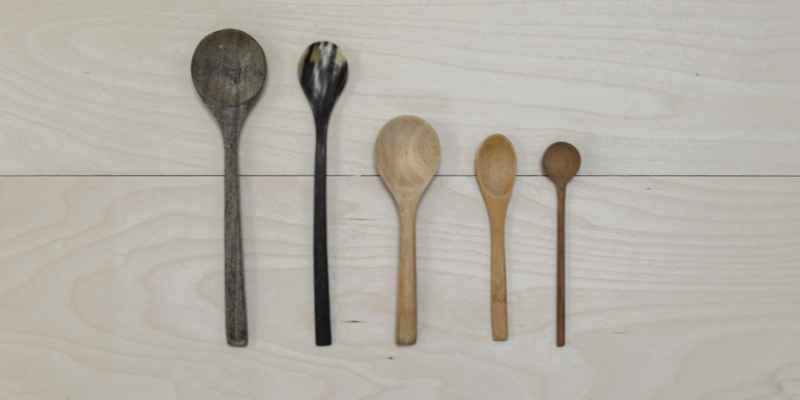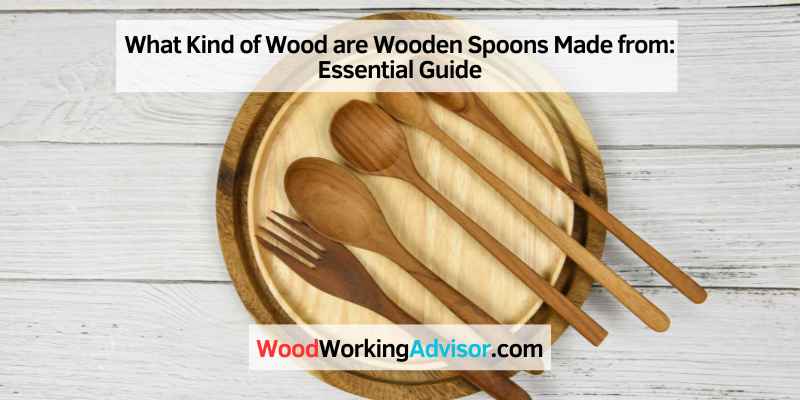Wooden spoons are typically made from hardwoods like beech, maple, cherry, or olive wood. These woods are durable and resistant to moisture, making them ideal for kitchen utensils.
In addition to their practicality, wooden spoons also add a touch of natural beauty to any culinary space. The choice of wood used can impact the spoon’s appearance, texture, and longevity. Whether you prefer a light-colored maple or a rich cherry wood, there are various options to suit your cooking style and aesthetic preferences.
Let’s delve deeper into the world of wooden spoons and explore the craftsmanship and artistry behind these essential kitchen tools.
The Art Of Crafting Wooden Spoons
Wooden spoons are not just kitchen utensils; they are a testament to the art of crafting. Let’s delve into the historical significance and modern-day resurgence of these humble yet versatile tools.
Historical Significance
Wooden spoons have been used for centuries, dating back to ancient civilizations. They were crafted from a variety of woods, including oak, maple, and cherry. Each wood type offered unique properties, influencing the spoon’s durability and functionality. In many cultures, the crafting of wooden spoons was considered an essential skill, often passed down through generations.
Modern-day Resurgence
In recent years, there has been a notable resurgence in the art of crafting wooden spoons. Artisans and woodworkers are rediscovering the beauty and functionality of handcrafted wooden utensils. This revival is driven by a growing appreciation for sustainable, eco-friendly products. Additionally, the unique aesthetic appeal and tactile experience of wooden spoons have contributed to their resurgence in modern kitchens.
Preferred Types Of Wood For Spoons
Wooden spoons are crafted from a variety of wood types, each offering unique benefits and characteristics. When selecting the ideal wood for crafting spoons, factors such as durability, grain pattern, and food safety must be considered.
Hardwoods Vs. Softwoods
Hardwoods, such as maple and cherry, are popular choices for wooden spoons due to their density and durability. Softwoods, like pine and cedar, are less commonly used for spoons as they are more prone to splintering and warping.
Popular Choices Across Cultures
Across various cultures, different wood types are favored for crafting wooden spoons. Olive wood is preferred in the Mediterranean region, while bamboo is popular in Asian cultures. Each wood type offers distinct aesthetic and functional properties.
Characteristics Of Ideal Spoon Wood
Wooden spoons are a timeless kitchen essential, valued for their natural beauty, durability, and versatility. The choice of wood used to craft these utensils significantly impacts their quality and performance. Understanding the characteristics of ideal spoon wood is essential for selecting the best utensils for your kitchen.
Durability Factors
Wooden spoons made from durable hardwoods such as maple, cherry, or walnut are ideal for withstanding the rigors of everyday use. These woods are resistant to warping, cracking, and splitting over time, ensuring the longevity of the spoon.
Grain Patterns And Aesthetics
The grain pattern of the wood contributes to the aesthetic appeal of wooden spoons. Fine, tight grain wood, such as cherry or maple, creates a smooth surface that is visually appealing and easy to clean. In contrast, open-grain woods like oak may not be as aesthetically pleasing for spoon making.
Top Wood Varieties For Durability

When it comes to durability, choosing the right wood variety is crucial for wooden spoons. Let’s explore the top wood varieties known for their resilience and strength.
Maple’s Resilience
Maple wood is highly durable and resistant to cracking, making it an excellent choice for wooden spoons.
The Strength Of Beech
Beech wood is known for its strength and longevity, making it ideal for utensils like wooden spoons.
Balancing Function And Form
When it comes to cooking utensils, wooden spoons are a timeless favorite. They are versatile, durable, and gentle on cookware. But have you ever wondered what kind of wood are wooden spoons made from? Balancing function and form, the choice of wood plays a crucial role in the spoon’s overall performance, aesthetic appeal, and longevity.
Ergonomic Design Considerations
Wooden spoons are shaped to fit comfortably in the hand, making them easy to use for long periods. Ergonomic design considerations include the handle’s length, width, and shape. The handle should be long enough to keep your hands safe from the heat, wide enough to provide a comfortable grip, and shaped to prevent slipping. The spoon’s bowl should be deep enough to hold a reasonable amount of food without spilling and shallow enough to scrape the bottom of a pan without damaging it.
Finishing For Beauty And Longevity
The choice of wood affects the spoon’s appearance, durability, and maintenance. Softwoods like pine or cedar may be cheaper, but they are prone to dents, scratches, and staining. Hardwoods like maple, cherry, or walnut are more expensive, but they are denser, stronger, and more resistant to wear and tear. The type of finish also plays a role in the spoon’s beauty and longevity.
Natural oils like mineral oil or beeswax can nourish the wood, protect it from moisture, and enhance its natural color and grain. However, they may need frequent reapplication. Polyurethane or varnish can provide a durable and glossy finish, but they may contain harmful chemicals and alter the wood’s texture and appearance.
In conclusion, choosing the right wood and finish for your wooden spoon can make a big difference in your cooking experience. Whether you prefer a classic or modern style, a light or dark shade, a smooth or textured surface, there is a wooden spoon that suits your needs and preferences. So next time you stir your favorite dish, take a moment to appreciate the beauty and functionality of your wooden spoon.
Sustainability In Spoon Making
Wooden spoons are commonly crafted from sustainable types of wood such as bamboo, beech, and olive. These materials are known for their durability and eco-friendly qualities, making them ideal choices for environmentally conscious spoon making. Additionally, these woods are naturally resistant to bacteria and gentle on cookware surfaces, ensuring a long-lasting kitchen utensil.
Eco-friendly Wood Sourcing
Wooden spoons are made from sustainably sourced wood types such as beech, maple, or olive wood.
Impact On Forest Management
Using sustainably sourced wood for spoons promotes responsible forest management practices.
Caring For Wooden Spoons
Wooden spoons can be made from a variety of woods such as beech, maple, cherry, and olive. To properly care for wooden spoons, they should be washed by hand and dried thoroughly to prevent warping or cracking. It’s also recommended to periodically oil the spoon to keep it from drying out.
Wooden spoons are a popular kitchen utensil used for stirring, mixing, and serving. They are made from various types of wood, including maple, olive, cherry, and bamboo. Wooden spoons are durable, easy to use, and gentle on cookware. Proper care is essential to maintain their quality and longevity. Here are some best practices to keep your wooden spoons in excellent condition.
Cleaning Best Practices
Cleaning your wooden spoons after every use is crucial to prevent bacteria and food residue buildup. Here are some cleaning best practices to follow:
- Hand wash your wooden spoons with warm water and mild soap.
- Avoid soaking them in water for an extended period as it can cause the wood to crack or warp.
- Use a soft sponge or cloth to clean the surface of the spoon.
- Rinse the spoon thoroughly with water and dry it with a clean towel.
Maintenance For Long-term Use
Proper maintenance is essential to keep your wooden spoons in excellent condition for long-term use. Here are some maintenance tips to follow:
- Apply a food-grade mineral oil to the spoon’s surface every few months to keep it moisturized and prevent cracking or splitting.
- Avoid storing your wooden spoons in a damp or humid environment as it can cause them to warp or develop mold.
- Store your wooden spoons in a dry and well-ventilated area.
- Avoid exposing them to direct sunlight or high temperatures as it can cause the wood to fade or crack.
In conclusion, wooden spoons are a useful and versatile kitchen utensil that requires proper care and maintenance to ensure their longevity. Follow these cleaning and maintenance best practices, and you can enjoy using your wooden spoons for years to come.
DIY Spoon Carving Basics
Discover the art of DIY spoon carving basics by understanding the ideal wood for crafting wooden spoons. Opt for hardwoods like maple, cherry, or walnut, known for their durability and food-safe properties. Experiment with different wood types to create unique and functional kitchen utensils.
Tools And Techniques
Carving a wooden spoon can be a satisfying and rewarding DIY project. To get started, you will need some basic tools such as a carving knife, a gouge, a coping saw, and sandpaper. The carving knife is the most important tool as it will be used to shape and carve the spoon. A gouge is also useful for hollowing out the bowl of the spoon. A coping saw is used to cut out the rough shape of the spoon, and sandpaper is used to smooth out any rough edges.
When it comes to techniques, it’s important to start with a good quality piece of wood. Hardwoods like cherry, maple, and walnut are ideal for carving as they are sturdy and durable. Begin by drawing the outline of the spoon onto the wood using a pencil. Then, use the coping saw to cut out the rough shape of the spoon. Use the carving knife to shape the handle and hollow out the bowl of the spoon. Finish by sanding the spoon to a smooth finish.
From Log To Spoon: The Process
The first step in making a wooden spoon is to select the wood. Look for a log that is straight and free from knots or cracks. Cut the log to the desired length and use a drawknife to remove the bark and rough outer layer. Next, split the log in half using a splitting maul and remove the pith with an adze or hatchet.
Once you have a smooth and flat surface, draw the outline of the spoon onto the wood. Use a coping saw to cut out the rough shape of the spoon, then use a carving knife and gouge to shape the handle and hollow out the bowl of the spoon. Finish by sanding the spoon to a smooth finish.
In conclusion, carving a wooden spoon is a fun and rewarding DIY project that requires some basic tools and techniques. With a little bit of practice, you can create beautiful and functional spoons that will last for years to come.

Frequently Asked Questions
What Kind Of Wood Are Wooden Spoons Made From?
Wooden spoons are typically made from hardwoods such as beech, maple, cherry, or olive wood. These types of wood are durable, food-safe, and resistant to staining and odor absorption. The choice of wood can also affect the spoon’s appearance and longevity.
Conclusion
Wooden spoons are crafted from a variety of wood types, each with its own unique characteristics and benefits. The most common woods used include beech, maple, cherry, and olive wood. These materials offer durability, heat resistance, and a natural beauty that enhances any kitchen.
When choosing a wooden spoon, consider the wood’s density, grain pattern, and sustainability. Remember, caring for your wooden spoon properly will ensure its longevity and maintain its quality. Happy cooking!


